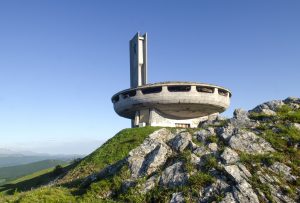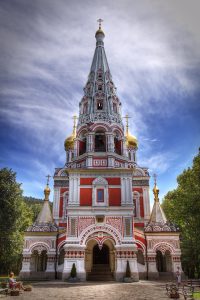In this series of posts, we will explore the sites in Southeastern Europe that are the modern-day counterparts to the ancient locales described and mentioned in our novel. We will also delve into what these sites offer visitors today!
In the previous installment of our “Travel Through Time” series, we explored the Valley of the Thracian Kings. However, beyond ancient Thracian sites and rose fields, there is plenty to see and do in the greater Kazanlak region. Therefore, ladies and gentlemen, please fasten your seatbelts and hang on tight as we explore the edges of the Kazanlak Valley—as well as what looms beyond the peaks on either side.
Overlooking the valley, a monument stands atop the summit of Shipka Peak that honors the heroism of 7,500 defenders of the Shipka Pass during the Russo-Turkish War of 1877-78. In August 1877, 5,000 Bulgarian volunteers and 2,500 Imperial Russian soldiers successfully defended the pass and warded off a massive Ottoman Turkish force of nearly 40,000. The fight was brutal—the defenders of Shipka ran out of ammunition, and they had to resort to throwing rocks and the bodies of their fallen comrades in order to repulse the Turks. A crucial turning point during the war, the Battle of Shipka helped lead to the eventual liberation of Bulgaria after nearly 500 years of Ottoman rule.

Across from Shipka Peak looms Buzludzha Peak, the setting of one of the most peculiar sites in all of Southeastern Europe. What is it? An imposing Communist-era monument that resembles a spaceship and looks like it belongs more on the set of a Star Wars movie than in the mountains of Bulgaria! Inaugurated in 1981, the Buzludzha monument was constructed by the Bulgarian Communist Party in order to commemorate the birth of the socialist movement in Bulgaria nearly a century prior.
Below these Balkan Mountain peaks, nestled in the foothills above the village of Shipka, is an Eastern Orthodox church that looks like it’s straight from a fairy tale! The Shipka Memorial Church, built in a Muscovite style, is dedicated to the soldiers from the Russian Empire and the Bulgarian lands who perished fighting for Bulgaria’s liberation during the Russo-Turkish War.

A few kilometers to the west of Shipka village lies the Damascena Ethnographic Complex, which consists of gardens, a museum, and a shop. The complex is an excellent place to learn more about the Kazanlak Valley’s rose industry as well as stock up on healthy Bulgarian rose (and lavender!) products.
If one were to fully cross the Balkan Mountains from the Valley of the Thracian Kings, what would he or she see on the other side? Just the other side of the mountain, as the popular children’s song says? Not quite, as several interesting attractions await visitors to the immediate north of the Balkan range!
One option is to visit Etar, an open-air replica of a traditional Bulgarian village. A great place to learn about traditional Bulgarian culture and crafts, Etar is something like the Bulgarian equivalent of Colonial Williamsburg, Virginia in the United States. A few kilometers north of Etar lies Gabrovo, the “humor capital” of Bulgaria. And further afield, one can travel to the beautiful town and popular tourist attraction of Veliko Tarnovo—best known for being the capital of the Second Bulgarian Empire during the Late Middle Ages.
Alternatively, if one were to travel in the opposite direction from the Valley of the Thracian Kings—south—they would reach the city of Stara Zagora, the sixth largest in Bulgaria. The city of “linden trees and poets”—as well as the renowned beer Zagorka—Stara Zagora may be relatively unassuming on the surface, but it harbors a fascinating and far-reaching past. In particular, the Neolithic Dwellings Museum contains the best two preserved dwellings from the 6th millennium BCE in Europe. These “8000-year-old houses” are among the oldest human buildings in the entire world, and a visit to the museum really is like transporting oneself back in time.
On that note… thank you once again for traveling through time with us today! In our next post, we will continue further west and follow in Trysimachus’s footsteps as we climb up to Kozi Gramadi Peak, where the Thracian king Amadokus once resided!

